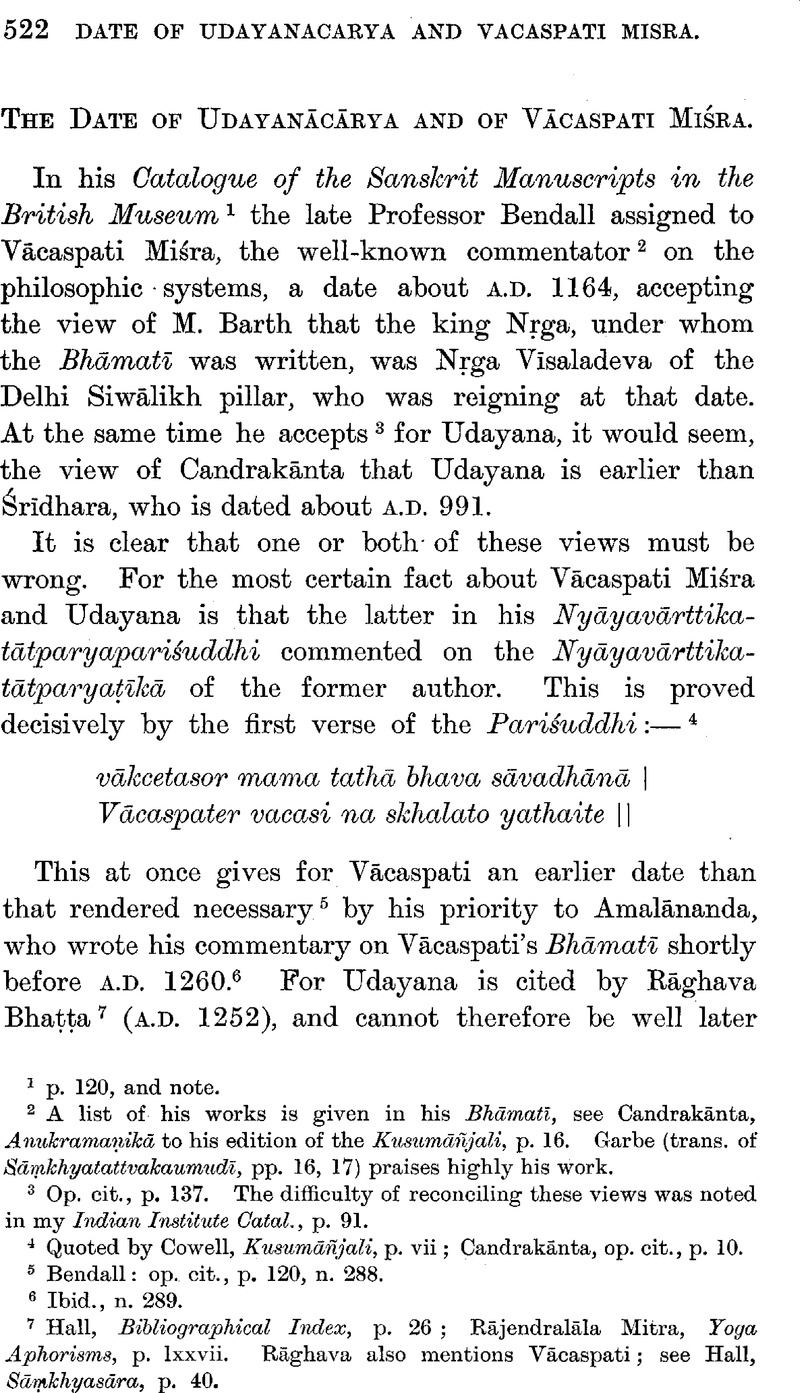No CrossRef data available.
Article contents
The Date of Udayanācārya and of Vācaspati Miśra
Published online by Cambridge University Press: 15 March 2011
Abstract

- Type
- Miscellaneous Communications
- Information
- Copyright
- Copyright © The Royal Asiatic Society 1908
References
page 522 note 1 p. 120, and note.
page 522 note 2 A list of his works is given in his Bhāmatī, see Candrakānta, , Anukramaṇikā to his edition of the Kusumñjali, p. 16Google Scholar. Garbe (trans, of Sāṃkhyatattvakaumudī, pp. 16, 17Google Scholar) praises highly his work.
page 522 note 3 Op. cit., p. 137Google Scholar. The difficulty of reconciling these views was noted in my Indian Institute Catal., p. 91.Google Scholar
page 522 note 4 Quoted by Cowell, , Kusumāñjali, p. viiGoogle Scholar; Candrakānta, , op. cit., p. 10.Google Scholar
page 522 note 5 Bendall, : op. cit., p. 120, n. 288.Google Scholar
page 522 note 6 Ibid., n. 289.
page 522 note 7 Hall, , Bibliographical Index, p. 26Google Scholar; Mitra, Rājendralāla, Yoga Aphorisms, p. lxxviiGoogle Scholar. Raghava also mentions Vācaspati; see Hall, , Sāṃkhyasāra, p. 40.Google Scholar
page 523 note 1 Op. cit., p. 15.Google Scholar
page 523 note 2 Ibid. He has—
tasmād asmābhir apy asminn arthe na Ichalu duṣpathā |
tvadgāthaivānyathākāram akṣarāni kiyanty api ||
vyāghāto yadi śaṅkāsti na cec chaṅka tarastarām |
vyāghātāvadhir sankā tarkaḥśaṅkāvadhiḥ kutaḥ ||
See Kusumāñjali, iii, 7Google Scholar. The only answer to this argument is to assume that in the Kusumāñjali the verse is not original.
page 523 note 3 J.B.R.A.S., x, 31; xi, 279 seq.Google Scholar
page 523 note 4 Op. cit., p. 19.Google Scholar
page 523 note 5 See Candrakānta, , p. 20.Google Scholar
page 523 note 6 See also Bühler, , Kaśmir Report, p. 76.Google Scholar
page 524 note 1 Calcutta, 1900, Bhūmikā.Google Scholar
page 524 note 2 He mentions a work on the Sāṃkhya in the Bhāmatī, and cf. the end of the Sāṃkhyatattvakanmudī.
page 524 note 3 The work seems only to be described on the best MSS. of the Sāṃhhyatattvakaumudī as Rājavārttika (cf. Aufrecht, , Bodleian Catal., p. 237Google Scholar; Garbe's trans., p. 111), and it is quite probable that the attribution to Bhoja (cf. Garbe, , Sāṃkhya Philosophie, p. 62, n. 2)Google Scholar may be incorrect, and may rest merely on a confusion with the Rājamārtaṇda, his commentary on the Yoga Sūtra.
page 524 note 4 There appears to be nothing to prevent us holding this, as far as the recorded history goes. Hall, (op. cit., p. viii)Google Scholar believed (though for reasons other than ours) in two Bhojas. Bhoja as the name of a king is presumably a complimentary title, and to Rājaśekhara is attributed by Harikavi in the Harihārāvali (Peterson, , Report, 1883–1884, pp. 59 seq.)Google Scholar a Bhojaprabandha. Peterson refers this to Bhoja of Dhārā, the beginning of whose reign he sets in A.D. 966, but this view is not now tenable. Konow, Karpūramañjarī, p. 196Google Scholar, thinks of the younger Rājaśekhara (A.D. 1347), but there was a Bhoja in A.D. 862–882, Epigr. Ind., i, p. 171Google Scholar, and the younger Rājaśekhara's work is, according to Bühler, written in barbarous Sanskrit prose.
page 525 note 1 i, 18; see Aufrecht, , op. cit., p. 121.Google Scholar
page 525 note 2 See references in Zachariae, , Die indisch. Wörterbüher, p. 28.Google Scholar
page 525 note 3 Cf. J.R.A.S., 1901, p. 579Google Scholar. Peterson's objections to this view (Subhāṣitāvali, p. 101Google Scholar) rest on the former erroneous view of Rājaśekhara's date; see Epigr. Ind., i, pp. 170–1Google Scholar. The idea of regarding the verses as not the dramatist's is peculiarly gratuitous; it is not suggested in one of the original authorities, and rests only on errors in dating the dramatist, but seems on the high road to general acceptance.
page 525 note 4 Cf. Peterson, , Report, 1883–1884, pp. 59, 61Google Scholar; Ind. Ant., xiv, p. 4. Probably Rājaśekhara knew Kavirājā also. He states that Surānanda, who was most probably his grandfather or great-grandfather, surpassed the poets Kavirāja and Tarala. It is certainly in favour of the identity of the Rājaśekhara of the verses on poets and the dramatist that in the former Tarala appears also a great poet and a member of Rājaśekhara's family.Google Scholar
page 525 note 5 Cf. Macdonell, , Sanskrit Literature, p. 331Google Scholar. Pischel, (Rudraṭa, p. 25)Google Scholar assigns him to the beginning of the eighth century, in view of his claim to be an equal of Subandhu and Bana. Konow, , op. cit., p. 183Google Scholar, simply denies the identity of the two Kavirājas.
page 525 note 6 On them, cf. Fleet, , Bombay Gazetteer, i, ii, pp. 285 seq.Google Scholar; Epigr. Ind., viii, 28.Google Scholar
page 525 note 7 Garbe, (Ber. der königl. sächs. Ges. der Wiss., Phil.-hist. Cl., 1888, p. 9Google Scholar; cf. Sāṃkhya Philosophie, p. 61, n. 1)Google Scholar holds that Vācaspati belongs to the first third of the eleventh century, which date also would exclude M. Barth's hypothesis. He bases his view, however, merely upon Cowell and Hall's results.
page 526 note 1 Mention should be made of Rājendralāla's view (op. cit., p. lxxvii)Google Scholar that the Bhoja of Vacaspati Misra is not the Bhoja of the eleventh century. Unfortunately he carries this view to the point of ascribing the Rājamārtaṇda on the Yoga Sūtra to the earlier Bhoja (pp. lxxxi, lxxxii) on the ground of the worthless Bhojaprabandha and of the fact of the existence of the astronomical Rjamārtaṃda, His objections are in the main removed by the fact that these works are, of course, not the king's own production, and the improbability of the Rājavārttika being Bhoja's is increased by the fact that the preface to the Rājamārtaṇḍa ignores that work.


